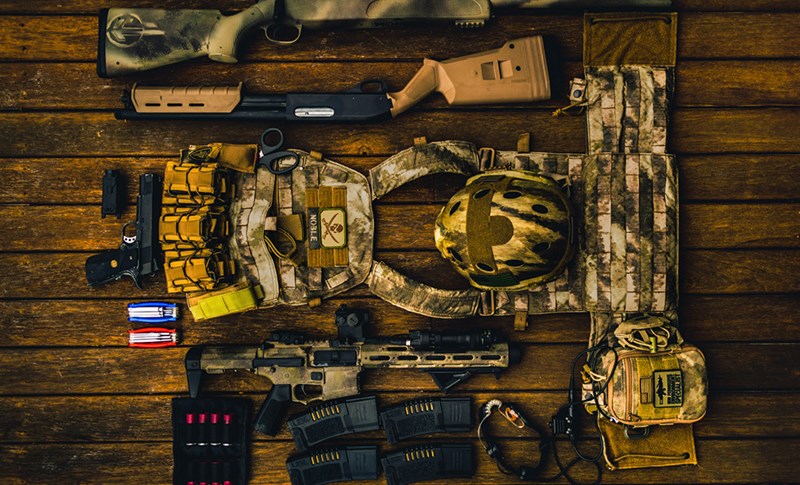

Despite public outcry, new federal data shows that 2014 and 2015 were peak years for shipments of surplus military
gear to local police departments across America.
This week our organizationa
released the study,
OpenTheBooks Snapshot Report – The Militarization of Local Police Departments, that quantified the transfer of 1.5 million weapons-related items from the Department of Defense (DoD) to federal, state and local law enforcement since 2006. New federal records show police agencies in Florida, Texas, California, Tennessee and Arizona led the nation in procuring surplus military-weaponry from the DoD over the last 10 years.
We
found a federally-sponsored ‘gun show’ that never ends: small town police are armed with M16 and M14 rifles, night-vision googles, bayonets and armored trucks; junior colleges and county sheriffs procured mine-resistant vehicles (MRVs); even local park districts and forest preserves stocked up on military-style equipment.
The 1033 Program created by the National Defense Authorization Act (1997) authorized the transfer of excess military equipment to civilian law enforcement.
In total, our new data reveals $2.2 billion worth of military gear including helicopters and airplanes, armored trucks and cars, tens of thousands of M16 and M14 rifles, thousands of bayonets, mine detectors and many other types of weaponry.
Thousands of units of government across America received military equipment. Using our mapping technology, citizens
can quickly search the military ‘gun lockers’ of your local government: park districts, forest preserves, hometown police departments, junior colleges, universities, county sheriffs, natural resource and public safety departments, state police – and Homeland Security, Interior and the Justice Department – across any ZIP code.
Here’s a cross-section of military-weaponry and equipment distributed to law enforcement:
- 7,091 trucks ($400.9 million); 625 mine-resistant vehicles (421.1 million); 471 helicopters ($158.3 million); 56 airplanes ($271.5 million); and 329 armored trucks and cars ($21.3 million);
- 83,122 M16/M14 rifles (5.56mm and 7.62mm) ($31.2 million); 8,198 pistols (.38 and .45 caliber) ($491,769); and 1,385 riot 12-guage shotguns ($137,265);
- 18,299 night-vision sights, sniper scopes, binoculars, goggles, infrared and image magnifiers ($98.5 million); 5,518 infrared, articulated, panoramic and laser telescopes ($5.5 million);
- 866 mine detecting sets, marking kits, and probes ($3.3 million); 57 grenade launchers ($41,040);
- 5,638 bayonets ($307,769) and 36 swords and scabbards.
A few examples of the local and regional law enforcement weaponry largess:
In Florida, the state highway patrol received 1,815 M16/M14 rifles (5.56mm and 7.62mm), plus six military-armored vehicles, three Mine Resistant Vehicles and three Complete Combat/Assault/Tactical Wheeled Vehicles.
In California, we found 18,794 DOD transactions transferring weaponry including nearly 7,500 trades involving M16/M14 rifles. The University of California at Berkley accepted the delivery of 14 M16 rifles. Yet that paled in comparison to the 1,105 M16/M14 rifles (5.56mm and 7.62mm) and two mine-resistant vehicles acquired by the Los Angeles County Sheriff.
In Washington, D.C., the Metropolitan Police procured 500 M16 rifles – which is half of what the entire state of New Jersey received in rifles. The DC Metro Transit police have also followed a federal procurement process
to obtain 134.5 lbs. of C4, TNT, potassium chlorate, semtex (plastic explosive), and other explosives over the next nine years.
Many small towns across America received military weapons. Granite City, IL (pop. 29,375) received 25 M16 and M14 rifles (5.56mm and 7.62mm), plus a military-armored truck and a robot for ‘explosive ordinance disposal.’ Lacon, IL (pop. 1,853) received six .45 and .38 special pistols, five M16/M14 (5.56mm and 7.63mm), and a 12-gage ‘riot’ shotgun.
Many of the DOD weapons transfers have a questionable law enforcement purpose. In Illinois, the Department of Natural Resources received 174 M16 and M14 rifles. Why? To enforce hunting laws?
On the battlefield of war, a bayonet in hand-to-hand combat is tactically used to bleed-out your enemies. So, exactly what is the legitimate law enforcement purpose for DHS, ATF, FBI, DEA and local police departments to obtain thousands of military-bayonets?
Our data shows 5,638 bayonets were sent to other federal law enforcement agencies or local police departments. Homeland Security (DHS) obtained 3,905 bayonets at 15 locations – with DHS Customs and Border Protection in El Paso, TX receiving 3,260 of those bayonets. The Justice Department (DOJ) secured 682 bayonets delivered to 16 locations of the ATF, FBI and DEA. To his credit, President Obama recognized this disconnect and signed an executive order prohibiting the transfer of bayonets starting in 2016.
It’s no secret the American people are distrustful of our political class, and rightly so. But transparency can help restore trust by giving people the information they need to hold elected officials accountable.
Adam Andrzejewski is the CEO of OpenTheBooks.com. The world’s largest private repository of public spending. See the military weaponry in your ZIP code, interactive-mapping tool here. Special thanks to IllinoisLeaks.com for their FOIA assistance.
The 1033 Program created by the National Defense Authorization Act (1997) authorized the transfer excess military equipment to civilian law enforcement. In 2015, President Obama signed Executive Order 13688 into law which limited and prohibited certain types of equipment transfer starting in 2016.